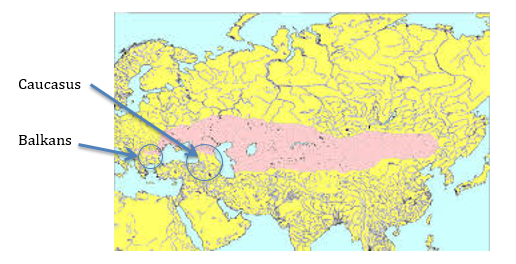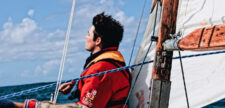Linguistic Residual Zone: New York City
Linguist Johanna Nichols has identified two types of geographic zones relevant for comparative work in linguistics: the linguistic residual zone and the linguistic spread zone.
Linguistic Residual Zones
A linguistic residual zone tends to be a relatively small, often geographically enclosed area. A higher number of languages from different language families are spoken here than in the areas surrounding it.
The Caucasus, the Balkans, Papua New Guinea, eastern Africa, northern Australia, the Amazon, and historic California all count as examples of a linguistic residual zone.
On the right, you can see the language map of the Caucasus.
Two features of residual zones are pertinent to this blog:
- Many of the languages have been there for a long time; and
- Over time, there is a net increase in the diversity of the languages spoken there. For this reason, a linguistic residual zone is also sometimes called a refuge. Languages take refuge there. However, they are not pushed into the zone, rather they are drawn into it.
Linguistic Spread Zones
A spread zone, by way of contrast, is a larger, geographically spacious area. It is one characterized by low linguistic diversity.
People with the latest technology – be it the wheel or the horse or the dog sled – will come into the area and sweep over it. Their language will dominate until the next wave of speakers with more powerful technology makes their sweep.
And so it may go for thousands of years.
Spread zones around the world include: the historic Eurasian steppe, the historic Ancient Near East, the historic Great Plains of North America, Siberia, the entire Arctic region, and sub-Saharan Africa.
The Eurasian steppe experienced many sweeps. The last was Mongolian, which was halted in its westward movement only by the Black Death around 1350.
One feature of spread zones is pertinent to my topic here. Usually only one language family and possibly only
one language dominate the area.
The sweep of this dominant language causes less dominant speaking groups in the area to seek refuge elsewhere (or be absorbed). The search for  refuge is, for instance, why the residual zones of the Caucasus and the Balkans are found at the periphery of the Eurasian steppe spread zone.
refuge is, for instance, why the residual zones of the Caucasus and the Balkans are found at the periphery of the Eurasian steppe spread zone.
When Nichols first proposed these terms and explored their features in 1992, she was still dealing with the linguistic world as it had organized itself in the last 2 – 10K years. Geographic features counted. Mountains and water provide natural enclosures for linguistic residual zones. Wide-open steppes and tundra allow for rapid spread.
That Was Then. This Is Now.
In the past decades of globalization, I now see that linguistic residual zones and spread zones still exist. However, specific geographic features no longer define them.
Today the whole world constitutes a spread zone. The means of the language spread is business and communication: global brands, blockbuster movies, the Internet.
The new residual zones are urban centers.
The language that has swept across the spread zone of the world is English.
Note: I’ve heard English now accounts for less than 1/3 of the tweets worldwide. Top three are Arabic, Russian, and Mandarin. I haven’t been able to confirm it.
The premier urban residual zone is New York City.
A recent story on NPR and an article in the New York Times turned the light bulb on in my head.
Here’s the opener from the Times:
“The chances of overhearing a conversation in Vlashki, a variant of Istro-Romanian, are greater in Queens than in the remote mountain villages in Croatia that immigrants now living in New York left years ago.
“At a Roman Catholic Church in the Morrisania section of the Bronx, Mass is said once a month in Garifuna, an Arawakan language that originated with descendants of African slaves shipwrecked near St. Vincent in the Caribbean and later exiled to Central America. Today, Garifuna is virtually as common in the Bronx and in Brooklyn as in Honduras and Belize.”
By some estimates over 800 languages are now spoken in New York City, making it a spectacular example of a linguistic residual zone.
Here’s the whole article: Listening to (and Saving) the World’s Languages
Why New York?
London has lots of linguistic diversity as does Paris and any other world capital.
Why does New York City attract even more diversity?
Since its founding in the 17th century, NYC has been a linguistic residual zone in the making, always attracting and maintaining a diversity of languages.
If NYC is the second most linguistically dense place on the planet, then what is the first?
 Answer: Papua New Guinea.
Answer: Papua New Guinea.
In light of more recent information, I may have to put NYC in first place and PNG in second.
Update: March, 2019. K. David Harrison has informed me that the South Pacific island of Vanuatu is the most linguistic diverse place in the world. It has a population of 276,000 people and 113 languages.
FURTHER READING:
Johanna Nichols, Linguistic Diversity in Time and Space (1992)
Julie Tetel Andresen and Phillip M. Carter Languages in the World. How History, Culture and Politics Shape Language (2016), in particular, Chapter Eight “Colonial Consequences.”
See also: All My Languages Blogs
Categorised in: Adventure, Language, North America
This post was written by Julie Tetel Andresen
You may also like these stories:
- google+
- comment




